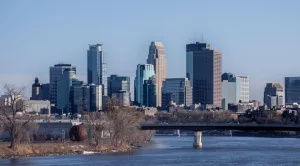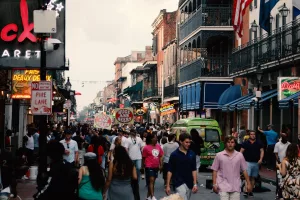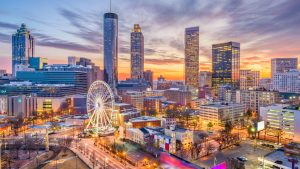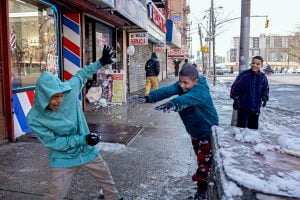5. Jordan
Jordan is a neighborhood in north Minneapolis that has a renter population. Of its 8,681 residents, the crime rate is 284% above the national average. The average income in Jordan is 50% below the national average, and many residents lack employment opportunities.
While violent crimes do happen, most reported incidents are related to property theft.
6. Ventura Village
Ventura Village is one of the most dangerous neighborhoods in Minneapolis. Located between downtown Minneapolis and Powderhorn, it has an approximate population of 4,800 residents. The crime rate in Ventura Village is 280% higher than the national average.
The neighborhood also faces significant poverty challenges, with an average income that is 59% below the national average. While some areas have undergone revitalization, crime remains a concern, particularly around Elliot Park and Nicollet Avenue.
7. Webber-Camden
Webber-Camden is a high-crime neighborhood in north Minneapolis near the Canadian Pacific Railway. With a population of approximately 5,164, the area’s crime rate is 254% higher than the national average.
Webber-Camden faces persistent challenges, including poverty, limited employment opportunities, and poorly rated schools. In 2023, 8,312 recorded criminal incidents were recorded, with property crime being the most common.
8. Uptown Minneapolis
Uptown is a commercial district in southwestern Minneapolis, comprised of four smaller neighborhoods, including the Seven Points area. With a population of 3,340, Uptown’s crime rate is 249% higher than the national average. In 2023, there were 8,182 reported criminal incidents, which included 756 violent crimes and 7,426 property crimes.
Much of the crime in Uptown involves theft, often targeting tourists. However, most of these incidents can be easily avoided by exercising common sense.
9. Cleveland
Cleveland is one of the most dangerous neighborhoods in Minneapolis. In the Camden community of northeast Minneapolis, Cleveland is a residential area filled with neighborhood bars, parks, and cafes. The city is home to Cleveland Park and borders the larger Folwell Park, which features a pond, playgrounds, and a recreation center. However, despite its suburban atmosphere, Cleveland experiences a high crime rate.
The total crime rate in Cleveland is 7,419 incidents for every 100,000 residents. This is 14% higher than the city average and 219% above the national average. The violent crime rate is 146% higher than the average for the city and 716% higher than the national average. Your odds of becoming a victim of crime in Cleveland are 1 in 14.
10. Sumner-Glenwood
Sumner-Glenwood is one of the most challenging areas in Minneapolis. The city is one of the six neighborhoods comprising the Near North section, located northwest of downtown. This neighborhood covers approximately 15 square blocks around the intersection of I-94 and Highway 55. Like many communities in the Near North, Sumner-Glenwood has a high crime rate.
The total crime rate is 6,566 crimes per 100,000 people, which is 183% higher than the national average. Additionally, the violent crime rate is 74% higher than the national average, and property crime is a staggering 478% higher. Consequently, the likelihood of becoming a victim of crime in this neighborhood is significant.
11. Hawthorne
Hawthorne is considered one of the most challenging neighborhoods in Minneapolis, MN. Located north of downtown along the Mississippi River, it has a population of 4,112. The crime rate in Hawthorne is 75% higher than the national average, and the average income is 50% lower than the national average.
As a result, many residents in the area face issues related to poverty and unemployment. Common crimes in Hawthorne include robbery, homicide, burglary, and shootings.
12. Folwell
Folwell is one of the most challenging neighborhoods in Minneapolis because of its high crime rate. Located northwest of the city, Folwell faces issues related to crime and unemployment, with the average income being 47% below the national average.
In 2023, 8,497 recorded criminal incidents, including assaults, robberies, and various types of property crimes, were recorded. Despite these statistics, many residents report feeling relatively safe in Folwell, although property crime remains the primary concern.
Conclusion
The D+ grade indicates that the crime rate in Minneapolis is higher than the average for cities in the United States. Specifically, Minneapolis ranks in the 27th percentile for safety, meaning that 73% of cities are safer and 27% are more dangerous. This assessment pertains only to the boundaries of the Minneapolis area. For additional context, please refer to the table below, which includes nearby cities.
The crime rate in Minneapolis is 28.93 per 1,000 residents annually. Residents generally consider the southwest area of the city to be the safest.
In Minneapolis, your chance of being a crime victim can be high. In central neighborhoods, it may be 1 in 19. It can be as low as 1 in 58 in the southwest part of the city. See the section on interpreting the crime map, however, because comparing rates for crime or any other crime is not as intuitive as it may seem.
 337% higher than the national average.
337% higher than the national average.

